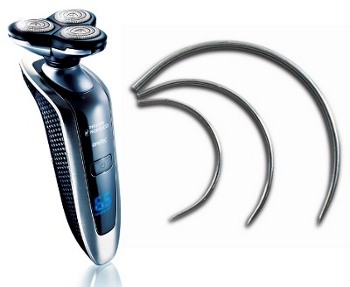 |
| February 28, 2012 | Volume 08 Issue 08 |
Designfax weekly eMagazine
Archives
Partners
Manufacturing Center
Product Spotlight
Modern Applications News
Metalworking Ideas For
Today's Job Shops
Tooling and Production
Strategies for large
metalworking plants
Quasicrystals strengthen high-performance steel
Sandvik, a Swedish engineering group known for its work in tooling, materials technology, mining, and construction, says that the Nobel Prize in Chemistry for 2011 awarded to Prof. Daniel Shechtman last October for the discovery of quasicrystals is intrinsically linked to the groundbreaking work the company has carried out in the field of nanotechnology for more than 20 years.

Sandvik Nanoflex is used on a range of products, including in a key shaver component and in medical instruments (like skin-piercing applications) and devices. Nanoflex is a high-performance steel alloy that uses quasicrystal technology.
When he announced his findings, Shechtman was met with incredulity and even asked to leave his research group. His persistence and stamina eventually persuaded scientists to reconsider their conception of the very nature of matter. Due to the initial skepticism met, the publication of his paper, "Metallic Phase with Long-Range Orientational Order and No Translational Symmetry," was delayed for more than two years after the original discovery on April 8, 1982.
A Swedish company makes similar findings
A decade later, in the early 1990s, Sandvik's R&D team at the time, consisting of Dr. Ping Liu, senior scientist, Dr. Anna Hultin Stigenberg, then PhD student, and Prof. Jan-Olof Nilsson, senior research expert, made a remarkably similar discovery of their own. They were attempting to find a very strong steel alloy for use in a wide range of products. What they found when they heated this alloy turned out to be quasicrystals, and it was the first time they had appeared in the conventional steel.
Liu and Nilsson both met with Shechtman. "I was truly pleased to hear the news of the 2011 Nobel Prize in Chemistry but not wholly surprised," says Nilsson. "I admire Dan Schechtman a great deal. He is a brave man that believes in his work. He came to visit us because he is extremely interested in learning how Sandvik uses his discovery of quasicrystals in different applications."
Today, Sandvik is a world leader in the use of quasicrystals in commercial materials and has a global patent on the steel in which quasicrystals are used. A close collaboration between shaver manufacturer Philips and Sandvik specialists led to the development of unique stainless strip steel based on Prof. Schechtman's original findings, which they named Sandvik Nanoflex (click for all material properties).
A unique material
Sandvik Nanoflex is a high-performance steel alloy specifically designed for applications requiring high strength and good ductility. Sandvik Nanoflex has a very high aging effect, is hardened by heat treatment, easy to weld and does not soften even when exposed to temperatures up to 450°C.
Low surface energy and a non-adhesive surface makes Sandvik Nanoflex a potentially useful material for the manufacture of engines and all sorts of moving mechanical parts.
Wide range of applications
The medical profession is among the industries that have benefitted from the breakthrough. Materials used in operations need to be hard and sharp enough to cut through human tissue, flexible and malleable enough to take on different shapes. "Eye and cardiovascular surgery are typical applications of this type of steel, as the material can bend without breaking," explains Pär Berglund, marketing manager for medical wire products.
Sandvik Nanoflex is also used in various skin piercing applications (surgical staples, retractable syringes, and needles used for vaccination and acupuncture, among other things) as well as for the manufacturing of surgical and microsurgical instruments (including blades, saws, bone drills, biopsy punches, and screwdrivers). "There is a clear 'before and after' in the medical profession," adds Berglund. "Our technology has made certain types of spine operations more of an option now, where the screwdrivers would break before but not when using Sandvik Nanoflex."
Future uses
Sandvik Nanoflex has been tested for use in a diverse range of products, including frying pans, components for energy-saving light-emitting diodes (LED), heat insulation in engines, even climbing equipment and bicycle frames. The material is also used in key shaver components by Philips, the world market leader in electric shaving.
By offering a complex grade of alloys, which have favorable ductility and, more importantly, impressive aging effects, Sandvik is able to deliver "soft" material that its customers can then stretch and mold for different applications.
"We partner with other companies when there are extremely complicated requirements," says Sören Olsson, business development engineer. "Sandvik Nanoflex possesses an unusual combination of different properties and offers a lot of possibilities for other products in the future.
The work of Prof. Schechtman challenged expectations and managed to alter the way atoms are perceived by the scientific community. Sandvik Nanoflex exists because of this determination, and everyone at Sandvik would like to congratulate Daniel Schechtman for his contribution to the modern world."
Editor's note: You can find a good NYT article about Daniel Shechtman here.
Want more information? Click below.
Source: Sandvik
Published February 2012
Rate this article
View our terms of use and privacy policy
